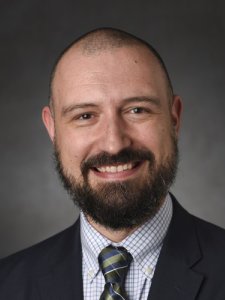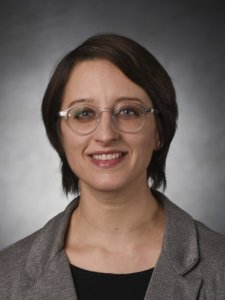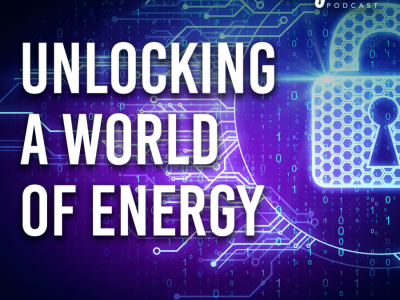Stephen Chmely and Chris Costello discuss how wind energy has a dirty secret surrounding the wind turbine blades and their disposal. The research team is exploring materials to reduce the waste associated with the blades.
Transcript
INTRO: This process that's ostensibly very environmentally friendly, has this dirty side where the actual material itself can't be recycled because of the way that it's made.
HOST: Welcome to Growing Impact, a podcast by the Institutes of Energy and the Environment at Penn State. Growing Impact explores cutting-edge projects of researchers and scientists who are solving some of the world's most challenging energy and environmental issues. Each project has been funded through an innovative seed grant program that is facilitated through IEE. I'm your host, Kevin Sliman. Today on Growing Impact, we speak with Chris Costello and Stephen Chmely, both of whom are assistant professors of Agricultural and Biological Engineering at Penn State. We speak about their work to find sustainable solutions for wind turbine blades.
HOST: Welcome to Growing Impact. Today, we are talking with Christine Costello and Stephen Chmely, and we are talking about their project “Lifecycle Analysis Design Framework for Sustainable Energy Infrastructure.” Welcome you both to the podcast.
Stephen Chmely (SC): Hey, Happy to be here. Thanks for having me.
Chris Costello (CC): Thanks, Kevin. Good to be here today.
HOST: Can we start with sustainable energy infrastructure and why it's important to be thinking about that?
CC: Sustainability is a big word, and I think we throw it around a lot. And it can mean a lot of things, right? Ideally, it means systems that are promoting environmental, economic, and social well-being now and indefinitely into the future, right? So that's really important. And particularly for energy, we really critically need energy, right? And we all sort of agree about how we're making the majority of our energy now is not contributing to the well-being of our environmental, social, and economic systems optimally. So it’s really important to figure out how we can sort of seamlessly transition. By that, I mean not having like massive interruptions to how much energy we have access to, to new systems that are less polluting, still economically viable, and also that don't exploit people.
HOST: Can you tell me how this project came about?
SC: We were interested in this particular project as it relates to wind energy production. So you could imagine that wind energy is probably one of the more environmentally friendly ways to generate electricity, for example. But we were really, or at least I was surprised to read an article, I think it was in the New York Times that said, you know, the sort of the dirty secret of wind energy production is that the actual wind energy rotors, the blades that we use to harvest the wind, are made of a material that at the end of its life is literally ground up and put in a landfill. This process that's ostensibly very environmentally friendly, has this dirty side where the actual material itself can't be recycled because of the way that it's made.
HOST: Can we talk about the dilemma with these blades? A, what are they made of now that's causing the problem and B how often are they taken out of service and ground up?
SC: The blades now are made out of fiberglass. Fiberglass is a composite material, and for the most part, composite materials are either very difficult or essentially impossible to recycle because they are a mixture of multiple materials, and they may have different profiles to, to be recycled. So for example, the matrix might need one thing to be recycled and the reinforcing fiber might need something else. And so, because they're so closely mixed together, it makes it very difficult to actually recycled them both simultaneously. There is fiberglass now and then the lifespan of the materials, I don't know the exact number, but we're talking a few decades, maybe 20 or 50 years. There'll be in service and then they're taken out of service and that's when they're there landfilled.
HOST: The project looking for materials that are potential replacements for fiberglass?
SC: Yes. So we we're interested in plant-based materials. My group does research on extracting value from what we call lignocellulosic biomass, which is essentially non-food biomass. All the stuff that's left over, like the structural components of plants as opposed to the food components of plants. And what we're interested in in this sense is a couple of things. Number one, the new material, so the matrix and the reinforcing fiber both coming from biomass, the matrix being lignin, and the reinforcing fiber being cellulose, which is actually how a plant functions as well. The plant builds its own structural material in much the same way.
HOST: Could you describe the goals of the project?
SC: What we were interested in was, can we make this material? Either recyclable or if we do grinded up and and put it in a landfill instead, could we actually make it in such a way that it enhances our ability to grow plants that we make the material from. So hopefully to sort of close that cycle and really make the whole process more sustainable from like the whole system perspective.
HOST: So how would grinding up the material and putting it back into the soil be helpful?
SC: You may have heard of bio char, which is like a soil amendment that's used to enhance like water retention and nutrient retention in soil. So it's not really the fertilizer itself, but it helps that the soil keeps all that together. And, and our hypothesis is that if we can make this material from plant matter, potentially when we grind it up, it might have the same sort of effect on soil as bio char, so it doesn't really fertilize, but it helps the soil maintain its natural propensity to absorb water and retain water and retain nutrients.
HOST: Chris, on your side of the project, can we talk about life-cycle analysis.
CC: On my side, we will be thinking about, okay, so what are all the materials that ended up on the way we might even think about our long-term carbon sequestration, right? Because if the blade is buried, carbon that is going to be stored for a long time and not have to think about if it's significant, but with ambitious goals of wind energy, it could be a decent amount. And then these questions like yeah, we have to, rather than shipping these blades, one blade at a time per truck bed. If we had additive manufacturing facilities closer to where a new big wind farm was going to be built with that save us impact as well. So try to optimize the whole thing all along the whole supply chain.
HOST: Is that what life-cycle analysis is? Is it looking at across the whole supply chain and looking for opportunities to improve it?
CC: Life-cycle assessment is called assessment analysis. It's the same thing. But the idea is that you take a detailed inventory of all the materials and energy flowing through each major process of a supply chain. So growing the lignocellulosic biomass, all the pre-treatment stages that you might have to do to isolate certain types of molecules, the lignocellulose, and then reassembling them into an engineered high-performance material. Whatever kind of logistics are involved. Assembly. In this case, we don't have a large use phase of the turbines just kind of producing energy. But there's other times when we want to think about these phases. And then final disposal. So is it going to be landfilled? In this case, it seems like it would be. Or burned or any of the areas that we have. And then accounting for all of those things across every single step that we can so we can simulate to get a sense of what happens. Not just in situ or not just the making of the blade, but actually like as we're kind of changing the system, what does it look like? One of the things I think is cool about this project that we're really trying to use LCA like from the beginning. And that’s really because of Stephen's interest and pulling people like with my kind of experience into the space. But it's really, I think it's really important to be involved early in the design because if we wait to do life-cycle assessment or any kind of sustainability analysis when like the design's already done and they've already basically locked into how they're going to make a thing, there's not a lot of opportunity to identify maybe problems that that could be addressed and mitigated.
HOST: Why is LCA important in this project?
SC: So we don't we don't waste our time doing things that aren't going to be more sustainable. It allows us to plan better and to really focus on the things that are going to make meaningful changes.
HOST: Can you talk a little bit about additive manufacturing and what that means for these wind turbine blades.
SC: If you've ever seen one of these rotor blades, right? We're talking like 50 meters. They’re huge, and to ship them, so you put them on a truck and you ship them across wherever they're going. And of course, that costs carbon dioxide. And so the question is, well, what if we could print them on site using this process with renewable materials? Could we have a real effect on the overall system, from start to finish? So we're trying to consider all of these things simultaneously.
HOST: Could you talk a little bit about why having interdisciplinary team in this kind of complex project, why that's really beneficial?
SC: Each person on the team has a very specific goal that they're looking at. But altogether, we're trying to solve this whole system of issues, so to speak. And, and so it's, I think it's, it's interesting and it's, it's a, it's a way to actually solve problems, right? You know, my background is synthetic chemistry. So I can sit in a lab and do reactions in a flask. But how do you turn that experiment into an actual technology that solves a problem? Well, then you need help from lots of different people along the supply chain and you have to get together in a team to really do that.
CC: It's the specific research tasks, but it's also the process of sitting together, hearing each other's language, learning what perspective where each kind of coming from. I mean, I think we're already having a lot of progress. I'm just kind of like learning so much from Stephen about green chemistry and sort of how the chemistry field thinks about sustainability. And that's helping me to think about how I'm, I guess I'm more from an ecological or environmental background. So it's really so important. These problems that we're facing like as a species, to be honest, are massively huge and they're going to require just a lot of thinking together, a lot of listening, and a lot of being open to finding a solution that maybe we didn't realize at first. You know, it's kinda like a less exciting discovery process. And like Stephen was saying, I mean, I just could never, it's probably wouldn't have been a product I would've thought out, right, but now I'm working with people who are doing these cool things of materials. So it's fun to work with people who are, you know, open to that and want to help figure it out. That's, that's a challenging process and takes time for them. I'm really excited. Penn State seems really dedicated to that way of thinking. And I'm, I'm grateful because I think that we absolutely have to get there.
HOST: Thank you for listening to grow an impact. Today we were talking about the project “Life-cycle Analysis Design Framework for Sustainable Energy Infrastructure.” We were speaking with Christine Castello and Stephen Chmely. Thank you both for being here.
CC: Thank you for having us and if anyone wants to reach out, please do. Thank you.
SC: Thanks, Kevin.
HOST: You have been listening to Growing Impact, a podcast by the Institutes of Energy and the Environment at Penn State. I've been your host, Kevin Sliman. This has been season 1, episode 3. Thank you for listening.









